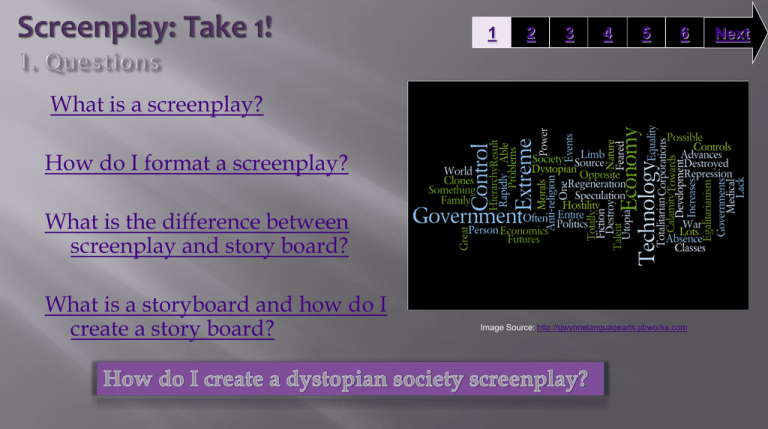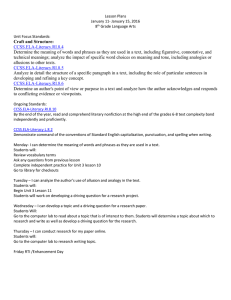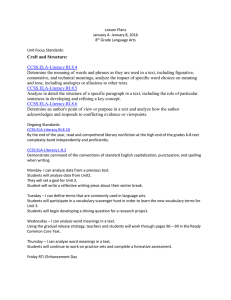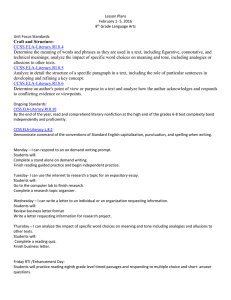
1
2
3
4
5
6
What is a screenplay?
How do I format a screenplay?
What is the difference between
screenplay and story board?
What is a storyboard and how do I
create a story board?
Image Source: http://gwynnelanguagearts.pbworks.com
Next
1
2
3
4
5
6
Next
A Satire of The Hunger Games: An
Excerpt from a Screenplay
Dystopian Screenplay excerpt example
with terms highlighted
Example of a 6th grade student’s
screenplay and storyboard
Glossary One
Glossary Two
Image: http://en.wikipedia.org/wiki/File:HungerGamesPoster.jpg
1
Student Resource Terms Chart
Examples of Transition Terms
Example of Camera Movements,
Shots & Angles *YouTube Video - must be
shown by teacher or viewed outside school
Click on the pictures to view videos.
2
3
4
5
6
Next
1
Using what you have learned about a Dystopian
Society, storyboard and screenplay, create a
story board of your scene and then create a
screenplay from your scene in the template
link below.
Dystopian Society Topic Examples:
Poverty – hunger
Bullying
Individual Rights
Privacy
Government Control
Part 1. Template for Storyboard
Part 2. Screenplay Pre-writing
Template for Screenplay
Screenplay Checklist
Screenplay Rubric
2
3
4
5
6
Next
1
2
3
4
5
6
Next
Would you like to add audio and lighting
effects to your scene?
In order to create your film, you just need a
Flip camera, phone camera or other
video recording device. Here are some
resources for shooting your film.
Flip Video Camera-Shoot and Edit
How to edit in MovieMaker
1
ELA Common Core Standards
Common Core State Standards
CCSS.ELA-Literacy.RI.6.7 CCSS.ELA-Literacy.RI.6.3
CCSS.ELA-Literacy.RI.6.5 CCSS.ELA-Literacy.W.6.3a
CCSS.ELA-Literacy.W.6.3b CCSS.ELA-Literacy.W.6.3c
CCSS.ELA-Literacy.W.6.3d CCSS.ELA-Literacy.W.6.3e
CCSS.ELA-Literacy.W.6.4 CCSS.ELA-Literacy.W.6.5
CCSS.ELA-Literacy.W.7.4 CCSS.ELA-Literacy.SL.7.2
Reading: 1. Read closely to determine what the text says explicitly and to make
logical inferences from it; cite specific textual evidence when writing or speaking
to support conclusions drawn from the text.
Writing: 7. Conduct short as well as more sustained research projects based on
focused questions, demonstrating understanding of the subject under
investigation.
Standards for the 21st Century Learner
1.1.6 Read, view, and listen for information presented in any format (e.g. textual,
visual, media, digital) in order to make inferences and gather meaning.
2.1.3 Use strategies to draw conclusions from information and apply knowledge
to curricular areas, real-world situations, and further investigations.
Maryland Technology Literacy Standards for Students
3.0: Use a variety of technologies for learning and collaboration.
2
3
4
5
6
Time Frame:
2-3 classes
Differentiation:
Direct students to use comprehension tools
Self-pace
Enrichment activities.
21st Century
LI.CT.ST.1
LI.CC.C.4
IMT.ML.CM.1
IMT.ICT.AP.1
LC.ISD.WI.1
Last updated: July 2015
Created by Ms. Kristi Szczepanski, English Teacher & Library Media Intern
BCPS Slam Dunk Research Model, Copyright 2013, Baltimore County Public Schools, MD, all rights reserved. The models may be used for educational, non-profit school use only.
All other uses, transmissions, and duplications are prohibited unless permission is granted expressly. This lesson is based on Jamie McKenzie’s Slam Dunk Lesson module.









